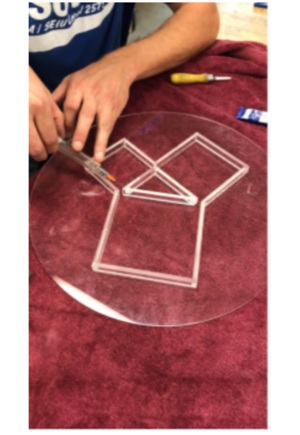
The Discovery Museum in Eureka are looking forward to being presented with projects that are suitable, hands-on, and engaging for young children. One of the projects requested is a Pythagorean Theorem model that helps children to visualize how this theorem works relating to areas of the sides of a right triangle.
Background[edit | edit source]
Team Butters consists of Mai Alqattan, Matthew Buck, Erik Nichols and Mercedes Weekly, created a Pythagorean Theorem demonstration that satisfies a set of criteria provided by the Museum.
Problem statement and criteria[edit | edit source]
| Criteria | Description | Weight |
|---|---|---|
| Durability | The project should be able to remain in the museum for the lifetime of its materials. | 8 |
| Cost | The design project must cost no more than $500. | 8 |
| Mobility | The design project must be able to move in and out of standard doorways, along with around the inside of the museum. | 5 |
| Maintainability | The components of the project should be easily maintained if necessary. | 6 |
| Safety | The project must be sturdy enough that it cannot be knocked over, cannot be in any way destroyed by children, and cannot cause harm to the audience. | 10 |
| Aesthetics | The project needs to appealing to the eye | 3 |
Description of final project[edit | edit source]
The final product is composed of acrylic, adhesive to bind it, and a brass plug. There are two circular pieces of acrylic that are 16 inches in diameter. In between those two pieces is the main part of the project, the Pythagorean model. There is a 3", 4", 5" triangle in the center, but the legs of the triangle are slightly shorter than these dimensions. Instead, they will be 2.5", 3.5", and 4.3" to allow fluid to flow around it. Off of the 3" leg there is a 3x3 square area, off of the 4" leg there is a 4x4 square area, and off of the 5" leg there is a 5x5 square area. There is a brass plug located in the center of the outer edge of of the 5x5 square area. This plug will be used to fill water into the 3x3 area and the 4x4 area completely in order to assure the correct amount of fluid is in the project. The fluid that is used is water with blue food coloring for added aesthetics.
Costs[edit | edit source]
| Spendings | Total ($) |
|---|---|
| Scrap | 18.72 |
| Ace Hardware | 6.49 |
| TAP Plastics | 46.55 |
| Total | 71.76 |
Testing Results[edit | edit source]
When the demonstration was filled with water, there was not any leakage.
Maintenance[edit | edit source]
The only required maintenance is to replace the water once a year. This process takes about 30 minutes
Instructions[edit | edit source]
Open the tightly closed lid and throw away the water that is in the demonstration. Mix water with the preferred food coloring. Refill the demonstration with that water.
Discussion[edit | edit source]
The design met the criteria because of the following reasons. It has a sturdy base which makes it durable. The cost didn't exceed the budget. The design has no choking hazard or sharp edges. The design dimensions make it very mobile. For aesthetics, the fluid is colored. The design is very easy to maintain because it takes only 30 minutes a year.